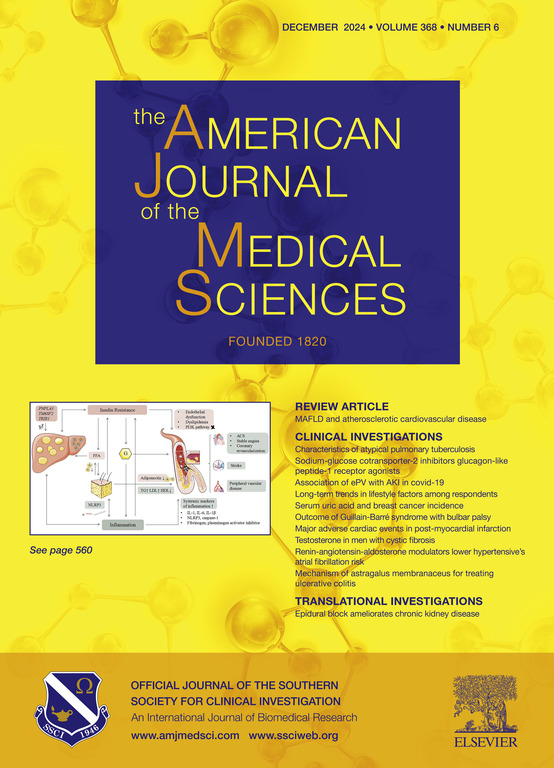Therapeutic efficacy of scopoletin on oxidative stress and cardiac dysfunction in streptozotocin-induced diabetic rats
IF 1.8
4区 医学
Q2 MEDICINE, GENERAL & INTERNAL
引用次数: 0
Abstract
Background
Cardiac dysfunction associated with diabetes often arises as a serious condition, primarily driven by persistent oxidative imbalance and chronic inflammation. There are few treatments for such complication and therefore, there is considerable interest in natural compounds such as scopoletin has antioxidative and anti-inflammatory activities. This study investigates how scopoletin may influence disease progression in a rat model of diabetic cardiomyopathy induced by streptozotocin (STZ).
Methods
Thirty-two male Wistar rats were evenly distributed into four study groups using a randomization protocol: a non-diabetic control, an untreated diabetic group, a diabetic group administered scopoletin, and a diabetic group treated with metformin (Glucophage) as a reference therapy. Post-diabetes induction by streptozotocin, treatments were administered for three weeks, subsequently, malondialdehyde (MDA) concentrations were measured along with, the enzymatic activities of key cardiac antioxidants—superoxide dismutase (SOD), catalase (CAT), and glutathione peroxidase (GPx)—were evaluated to assess oxidative defense status. ATPase activities, gene expression (p53 and VCAM-1), and histopathological examinations of heart tissues.
Results
Scopoletin treatment significantly reduced MDA levels by up to 35 %, with p < 0.01 compared to the diabetic control. Antioxidant enzyme activities were notably enhanced, with increases in SOD, CAT, and GPx activities by approximately 50 % (p < 0.01). Cardiac ATPase activities showed marked improvement (p < 0.05), and the expression of p53 and VCAM-1 was effectively downregulated (p < 0.01). Histopathological analysis revealed substantial reductions in myocardial damage, vacuolation, and tissue congestion in scopoletin-treated groups, with the high-dose effects comparable to those observed with metformin (Glucophage).
Conclusions
Scopoletin demonstrates significant potential in treating diabetic cardiomyopathy. These results encourage further clinical trials to explore scopoletin as a complementary therapy for cardiac complications in diabetic patients.
东莨菪碱对链脲佐菌素诱导的糖尿病大鼠氧化应激和心功能障碍的治疗作用。
背景:与糖尿病相关的心功能障碍通常是一种严重的疾病,主要由持续的氧化失衡和慢性炎症驱动。这种并发症的治疗方法很少,因此,人们对具有抗氧化和抗炎活性的天然化合物如东莨菪碱非常感兴趣。本研究探讨东莨菪碱如何影响链脲佐菌素(STZ)诱导的糖尿病性心肌病大鼠模型的疾病进展。方法:32只雄性Wistar大鼠采用随机化方案,均匀地分为4个研究组:非糖尿病对照组、未经治疗的糖尿病组、糖尿病组给予东莨菪碱治疗,糖尿病组给予二甲双胍作为参考治疗。用链脲唑菌素诱导糖尿病后,给予治疗三周,随后测量丙二醛(MDA)浓度,并评估关键心脏抗氧化剂——超氧化物歧化酶(SOD)、过氧化氢酶(CAT)和谷胱甘肽过氧化物酶(GPx)的酶活性,以评估氧化防御状态。atp酶活性,基因表达(p53和VCAM-1),以及心脏组织的组织病理学检查。结果:与糖尿病对照组相比,东莨菪碱治疗可显著降低MDA水平达35%,p < 0.01。抗氧化酶活性显著增强,SOD、CAT和GPx活性提高约50% (p < 0.01)。心肌atp酶活性明显提高(p < 0.05), p53、VCAM-1表达明显下调(p < 0.01)。组织病理学分析显示,东莨菪碱治疗组心肌损伤、空泡形成和组织充血显著减少,其高剂量效应与二甲双胍相当。结论:东莨菪碱对糖尿病性心肌病有较好的治疗作用。这些结果鼓励进一步的临床试验,探索东莨菪碱作为糖尿病患者心脏并发症的补充治疗。
本文章由计算机程序翻译,如有差异,请以英文原文为准。
求助全文
约1分钟内获得全文
求助全文
来源期刊
CiteScore
4.40
自引率
0.00%
发文量
303
审稿时长
1.5 months
期刊介绍:
The American Journal of The Medical Sciences (AJMS), founded in 1820, is the 2nd oldest medical journal in the United States. The AJMS is the official journal of the Southern Society for Clinical Investigation (SSCI). The SSCI is dedicated to the advancement of medical research and the exchange of knowledge, information and ideas. Its members are committed to mentoring future generations of medical investigators and promoting careers in academic medicine. The AJMS publishes, on a monthly basis, peer-reviewed articles in the field of internal medicine and its subspecialties, which include:
Original clinical and basic science investigations
Review articles
Online Images in the Medical Sciences
Special Features Include:
Patient-Centered Focused Reviews
History of Medicine
The Science of Medical Education.

 求助内容:
求助内容: 应助结果提醒方式:
应助结果提醒方式:


